Organizational Behavior: Leadership and Employee Engagement Report
VerifiedAdded on 2022/11/07
|15
|3467
|111
Report
AI Summary
This report analyzes the organizational behavior of XYZ Training Consultancy, comparing the leadership styles of Tim Redkin and his daughter Fiona. It examines employee engagement theory, organizational justice, and equity theory to explain changes in employee motivation and attrition. The report critiques Fiona's leadership, highlighting the impact of her autocratic style on workplace culture, employee relationships, and pay structures. It discusses leadership theories, including cultural and ethical leadership, and proposes changes to increase employee motivation and engagement. The analysis uses a framework of questions to evaluate the impact of leadership on organizational outcomes, providing insights into the importance of equitable practices and employee involvement.
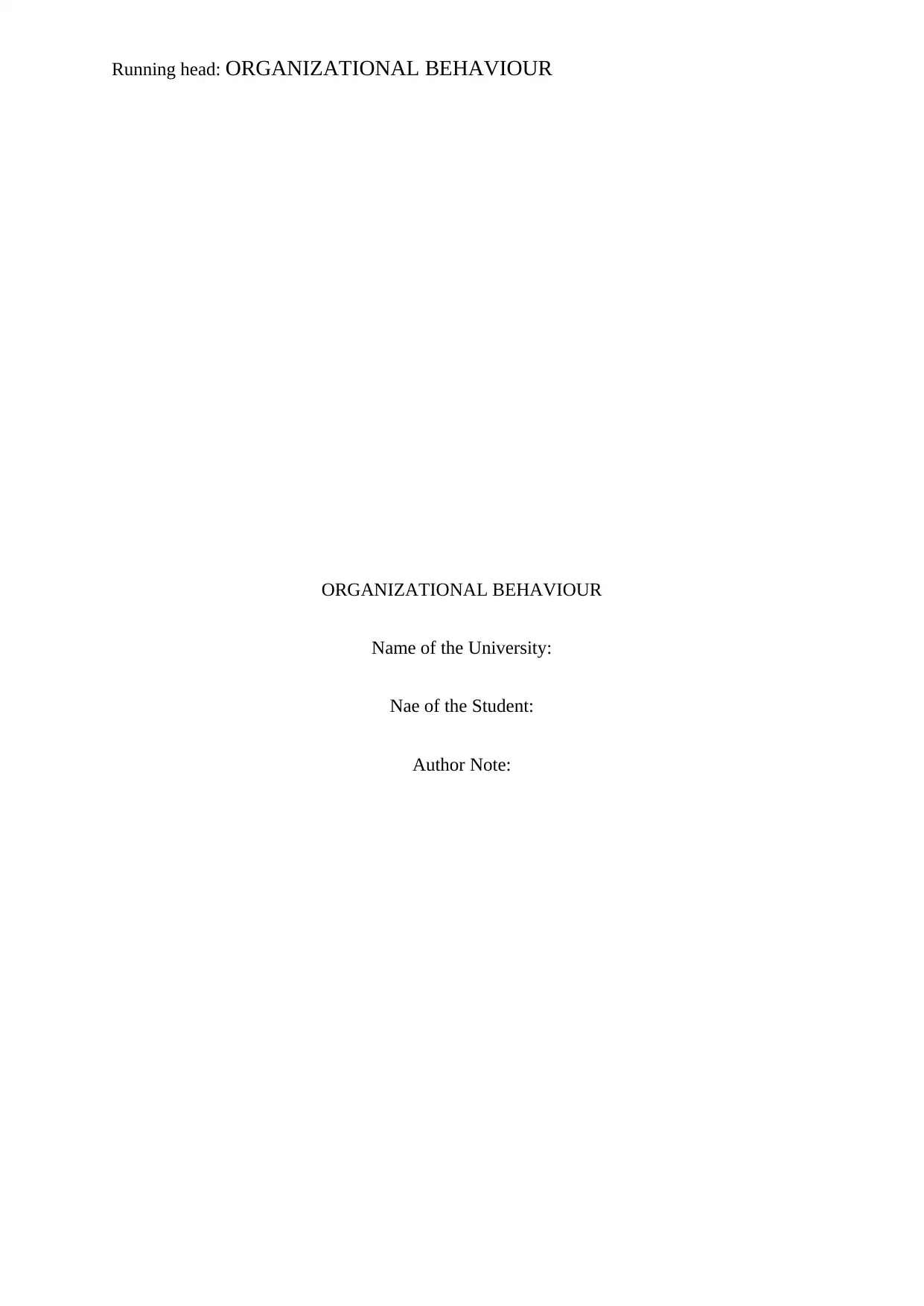
Running head: ORGANIZATIONAL BEHAVIOUR
ORGANIZATIONAL BEHAVIOUR
Name of the University:
Nae of the Student:
Author Note:
ORGANIZATIONAL BEHAVIOUR
Name of the University:
Nae of the Student:
Author Note:
Paraphrase This Document
Need a fresh take? Get an instant paraphrase of this document with our AI Paraphraser
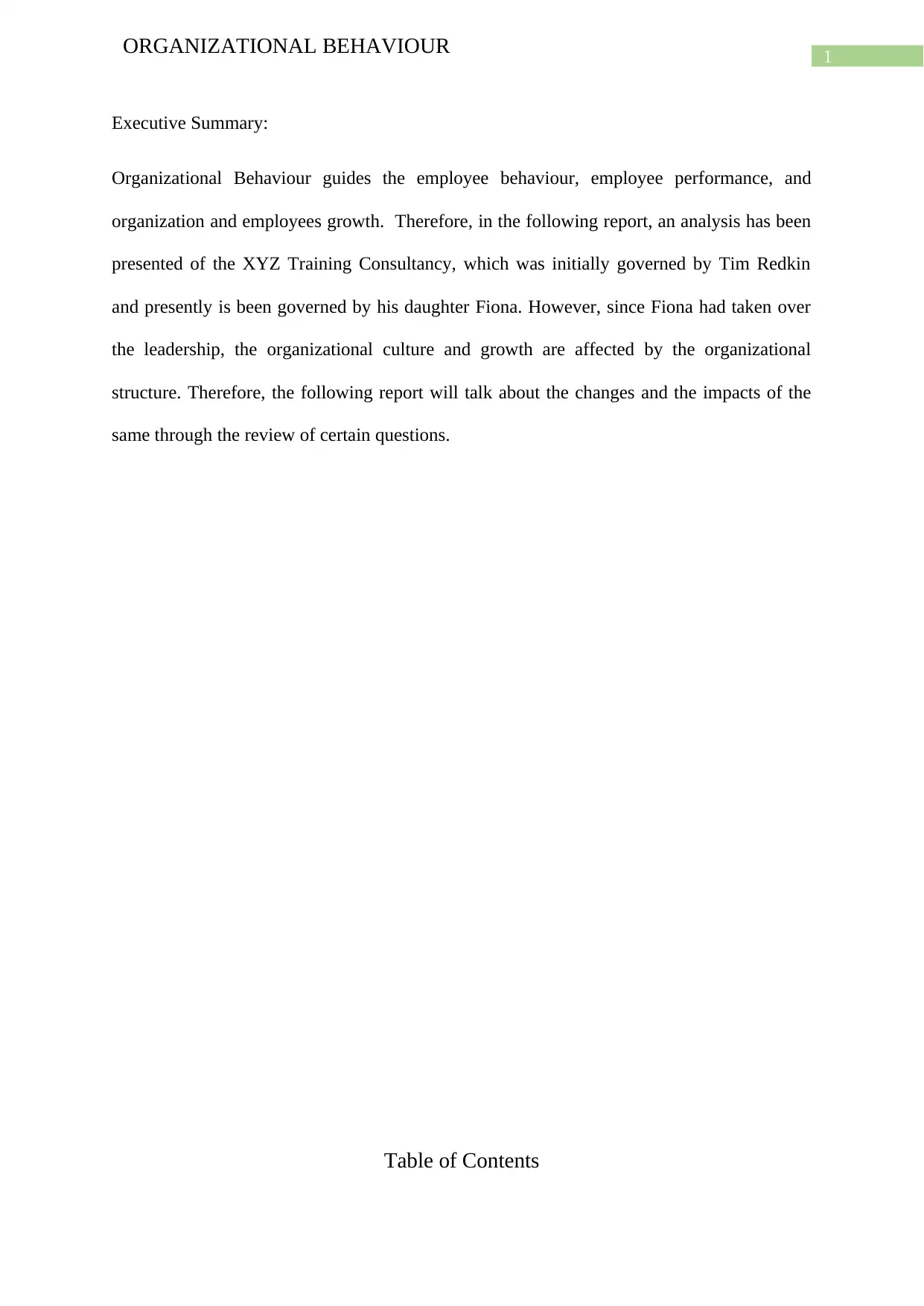
1
ORGANIZATIONAL BEHAVIOUR
Executive Summary:
Organizational Behaviour guides the employee behaviour, employee performance, and
organization and employees growth. Therefore, in the following report, an analysis has been
presented of the XYZ Training Consultancy, which was initially governed by Tim Redkin
and presently is been governed by his daughter Fiona. However, since Fiona had taken over
the leadership, the organizational culture and growth are affected by the organizational
structure. Therefore, the following report will talk about the changes and the impacts of the
same through the review of certain questions.
Table of Contents
ORGANIZATIONAL BEHAVIOUR
Executive Summary:
Organizational Behaviour guides the employee behaviour, employee performance, and
organization and employees growth. Therefore, in the following report, an analysis has been
presented of the XYZ Training Consultancy, which was initially governed by Tim Redkin
and presently is been governed by his daughter Fiona. However, since Fiona had taken over
the leadership, the organizational culture and growth are affected by the organizational
structure. Therefore, the following report will talk about the changes and the impacts of the
same through the review of certain questions.
Table of Contents
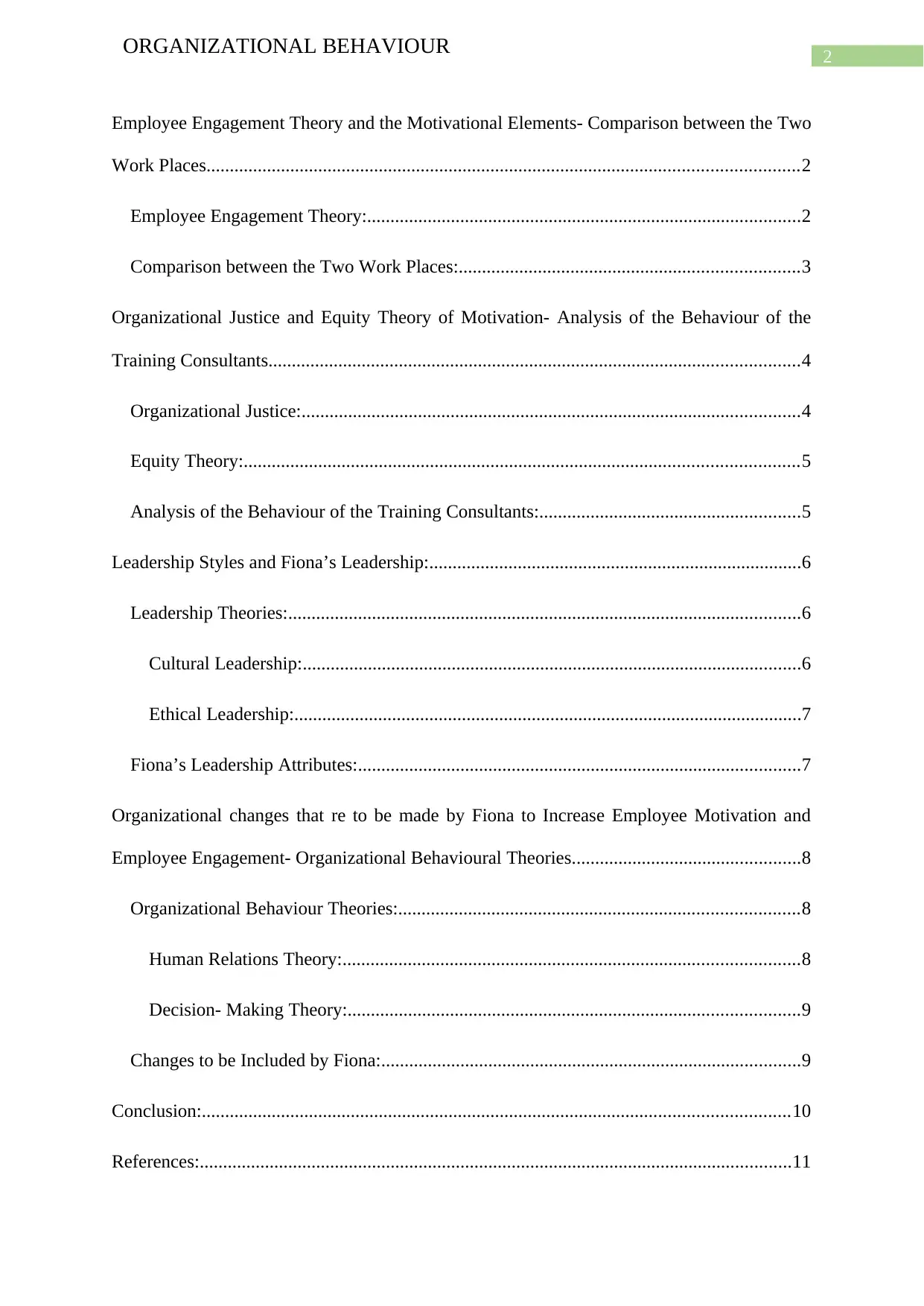
2
ORGANIZATIONAL BEHAVIOUR
Employee Engagement Theory and the Motivational Elements- Comparison between the Two
Work Places...............................................................................................................................2
Employee Engagement Theory:.............................................................................................2
Comparison between the Two Work Places:.........................................................................3
Organizational Justice and Equity Theory of Motivation- Analysis of the Behaviour of the
Training Consultants..................................................................................................................4
Organizational Justice:...........................................................................................................4
Equity Theory:.......................................................................................................................5
Analysis of the Behaviour of the Training Consultants:........................................................5
Leadership Styles and Fiona’s Leadership:................................................................................6
Leadership Theories:..............................................................................................................6
Cultural Leadership:...........................................................................................................6
Ethical Leadership:.............................................................................................................7
Fiona’s Leadership Attributes:...............................................................................................7
Organizational changes that re to be made by Fiona to Increase Employee Motivation and
Employee Engagement- Organizational Behavioural Theories.................................................8
Organizational Behaviour Theories:......................................................................................8
Human Relations Theory:..................................................................................................8
Decision- Making Theory:.................................................................................................9
Changes to be Included by Fiona:..........................................................................................9
Conclusion:..............................................................................................................................10
References:...............................................................................................................................11
ORGANIZATIONAL BEHAVIOUR
Employee Engagement Theory and the Motivational Elements- Comparison between the Two
Work Places...............................................................................................................................2
Employee Engagement Theory:.............................................................................................2
Comparison between the Two Work Places:.........................................................................3
Organizational Justice and Equity Theory of Motivation- Analysis of the Behaviour of the
Training Consultants..................................................................................................................4
Organizational Justice:...........................................................................................................4
Equity Theory:.......................................................................................................................5
Analysis of the Behaviour of the Training Consultants:........................................................5
Leadership Styles and Fiona’s Leadership:................................................................................6
Leadership Theories:..............................................................................................................6
Cultural Leadership:...........................................................................................................6
Ethical Leadership:.............................................................................................................7
Fiona’s Leadership Attributes:...............................................................................................7
Organizational changes that re to be made by Fiona to Increase Employee Motivation and
Employee Engagement- Organizational Behavioural Theories.................................................8
Organizational Behaviour Theories:......................................................................................8
Human Relations Theory:..................................................................................................8
Decision- Making Theory:.................................................................................................9
Changes to be Included by Fiona:..........................................................................................9
Conclusion:..............................................................................................................................10
References:...............................................................................................................................11
⊘ This is a preview!⊘
Do you want full access?
Subscribe today to unlock all pages.

Trusted by 1+ million students worldwide
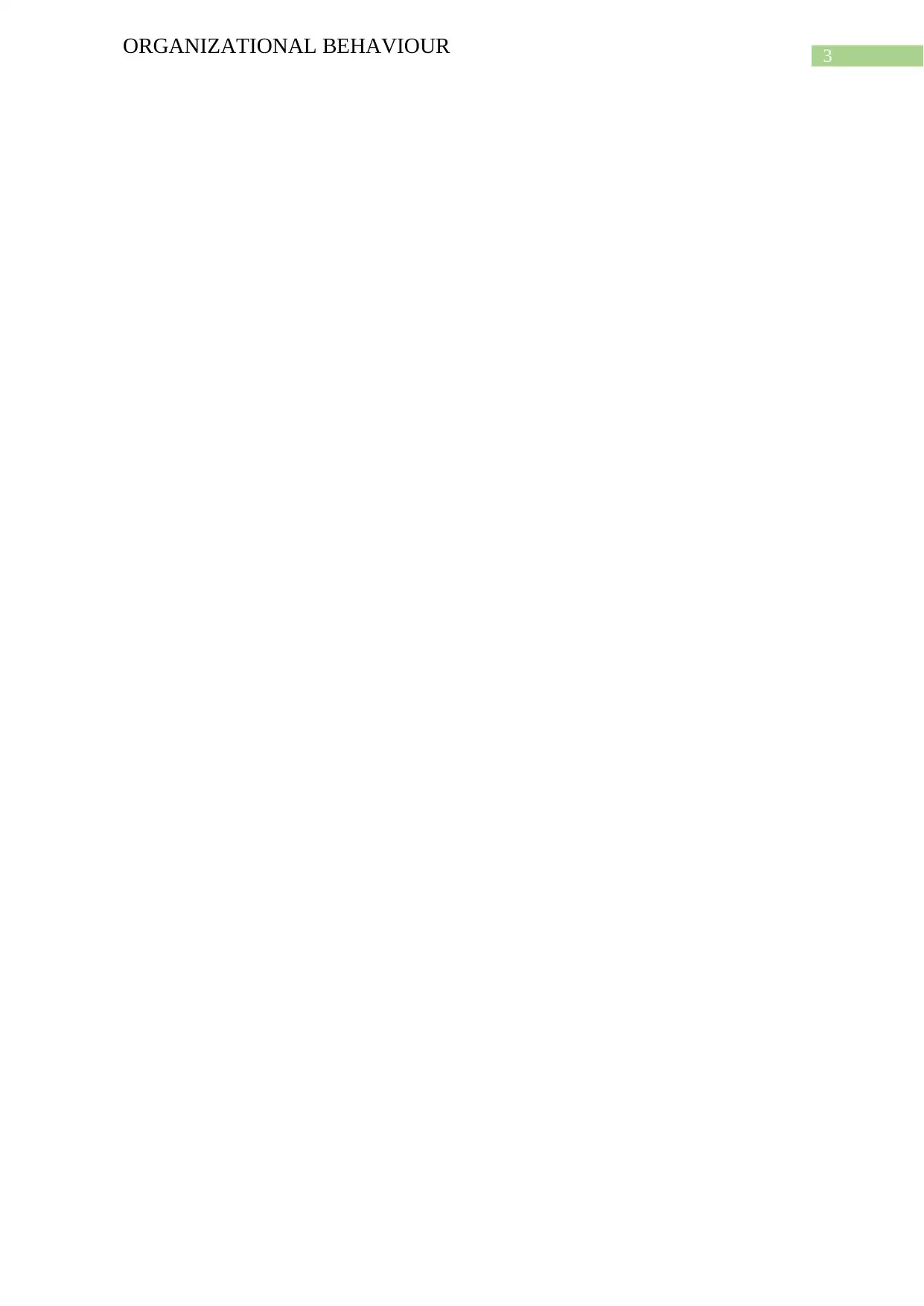
3
ORGANIZATIONAL BEHAVIOUR
ORGANIZATIONAL BEHAVIOUR
Paraphrase This Document
Need a fresh take? Get an instant paraphrase of this document with our AI Paraphraser
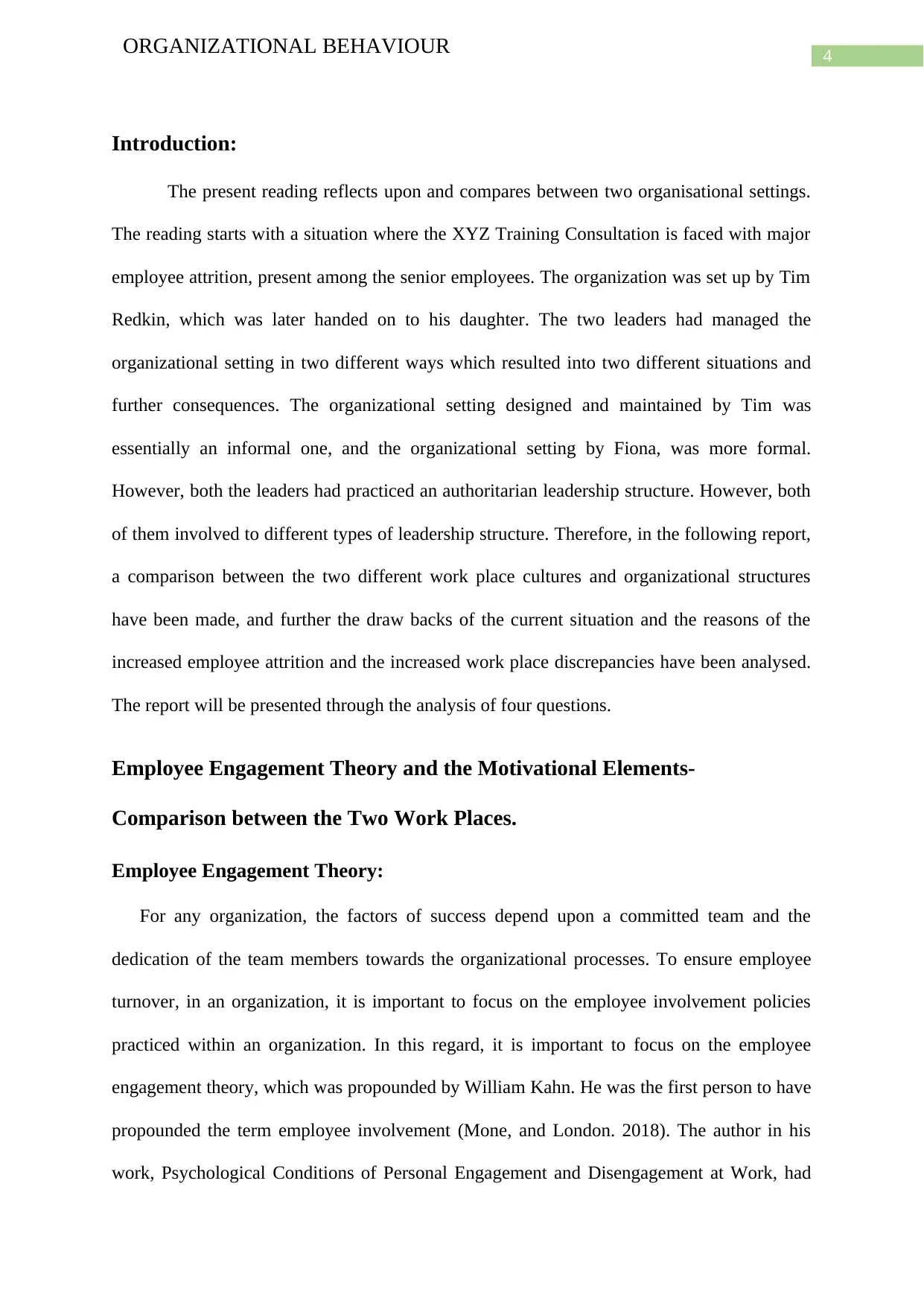
4
ORGANIZATIONAL BEHAVIOUR
Introduction:
The present reading reflects upon and compares between two organisational settings.
The reading starts with a situation where the XYZ Training Consultation is faced with major
employee attrition, present among the senior employees. The organization was set up by Tim
Redkin, which was later handed on to his daughter. The two leaders had managed the
organizational setting in two different ways which resulted into two different situations and
further consequences. The organizational setting designed and maintained by Tim was
essentially an informal one, and the organizational setting by Fiona, was more formal.
However, both the leaders had practiced an authoritarian leadership structure. However, both
of them involved to different types of leadership structure. Therefore, in the following report,
a comparison between the two different work place cultures and organizational structures
have been made, and further the draw backs of the current situation and the reasons of the
increased employee attrition and the increased work place discrepancies have been analysed.
The report will be presented through the analysis of four questions.
Employee Engagement Theory and the Motivational Elements-
Comparison between the Two Work Places.
Employee Engagement Theory:
For any organization, the factors of success depend upon a committed team and the
dedication of the team members towards the organizational processes. To ensure employee
turnover, in an organization, it is important to focus on the employee involvement policies
practiced within an organization. In this regard, it is important to focus on the employee
engagement theory, which was propounded by William Kahn. He was the first person to have
propounded the term employee involvement (Mone, and London. 2018). The author in his
work, Psychological Conditions of Personal Engagement and Disengagement at Work, had
ORGANIZATIONAL BEHAVIOUR
Introduction:
The present reading reflects upon and compares between two organisational settings.
The reading starts with a situation where the XYZ Training Consultation is faced with major
employee attrition, present among the senior employees. The organization was set up by Tim
Redkin, which was later handed on to his daughter. The two leaders had managed the
organizational setting in two different ways which resulted into two different situations and
further consequences. The organizational setting designed and maintained by Tim was
essentially an informal one, and the organizational setting by Fiona, was more formal.
However, both the leaders had practiced an authoritarian leadership structure. However, both
of them involved to different types of leadership structure. Therefore, in the following report,
a comparison between the two different work place cultures and organizational structures
have been made, and further the draw backs of the current situation and the reasons of the
increased employee attrition and the increased work place discrepancies have been analysed.
The report will be presented through the analysis of four questions.
Employee Engagement Theory and the Motivational Elements-
Comparison between the Two Work Places.
Employee Engagement Theory:
For any organization, the factors of success depend upon a committed team and the
dedication of the team members towards the organizational processes. To ensure employee
turnover, in an organization, it is important to focus on the employee involvement policies
practiced within an organization. In this regard, it is important to focus on the employee
engagement theory, which was propounded by William Kahn. He was the first person to have
propounded the term employee involvement (Mone, and London. 2018). The author in his
work, Psychological Conditions of Personal Engagement and Disengagement at Work, had
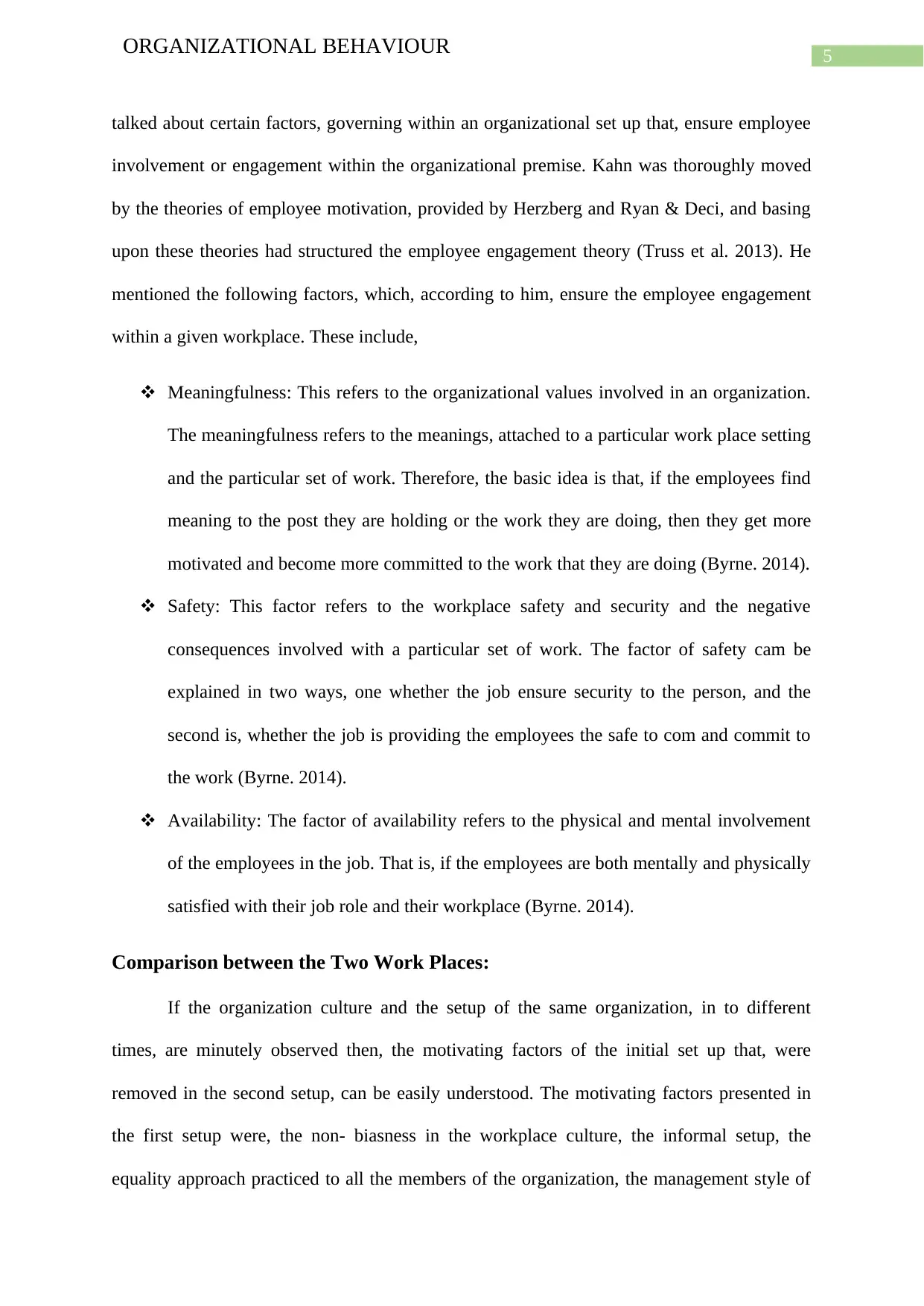
5
ORGANIZATIONAL BEHAVIOUR
talked about certain factors, governing within an organizational set up that, ensure employee
involvement or engagement within the organizational premise. Kahn was thoroughly moved
by the theories of employee motivation, provided by Herzberg and Ryan & Deci, and basing
upon these theories had structured the employee engagement theory (Truss et al. 2013). He
mentioned the following factors, which, according to him, ensure the employee engagement
within a given workplace. These include,
Meaningfulness: This refers to the organizational values involved in an organization.
The meaningfulness refers to the meanings, attached to a particular work place setting
and the particular set of work. Therefore, the basic idea is that, if the employees find
meaning to the post they are holding or the work they are doing, then they get more
motivated and become more committed to the work that they are doing (Byrne. 2014).
Safety: This factor refers to the workplace safety and security and the negative
consequences involved with a particular set of work. The factor of safety cam be
explained in two ways, one whether the job ensure security to the person, and the
second is, whether the job is providing the employees the safe to com and commit to
the work (Byrne. 2014).
Availability: The factor of availability refers to the physical and mental involvement
of the employees in the job. That is, if the employees are both mentally and physically
satisfied with their job role and their workplace (Byrne. 2014).
Comparison between the Two Work Places:
If the organization culture and the setup of the same organization, in to different
times, are minutely observed then, the motivating factors of the initial set up that, were
removed in the second setup, can be easily understood. The motivating factors presented in
the first setup were, the non- biasness in the workplace culture, the informal setup, the
equality approach practiced to all the members of the organization, the management style of
ORGANIZATIONAL BEHAVIOUR
talked about certain factors, governing within an organizational set up that, ensure employee
involvement or engagement within the organizational premise. Kahn was thoroughly moved
by the theories of employee motivation, provided by Herzberg and Ryan & Deci, and basing
upon these theories had structured the employee engagement theory (Truss et al. 2013). He
mentioned the following factors, which, according to him, ensure the employee engagement
within a given workplace. These include,
Meaningfulness: This refers to the organizational values involved in an organization.
The meaningfulness refers to the meanings, attached to a particular work place setting
and the particular set of work. Therefore, the basic idea is that, if the employees find
meaning to the post they are holding or the work they are doing, then they get more
motivated and become more committed to the work that they are doing (Byrne. 2014).
Safety: This factor refers to the workplace safety and security and the negative
consequences involved with a particular set of work. The factor of safety cam be
explained in two ways, one whether the job ensure security to the person, and the
second is, whether the job is providing the employees the safe to com and commit to
the work (Byrne. 2014).
Availability: The factor of availability refers to the physical and mental involvement
of the employees in the job. That is, if the employees are both mentally and physically
satisfied with their job role and their workplace (Byrne. 2014).
Comparison between the Two Work Places:
If the organization culture and the setup of the same organization, in to different
times, are minutely observed then, the motivating factors of the initial set up that, were
removed in the second setup, can be easily understood. The motivating factors presented in
the first setup were, the non- biasness in the workplace culture, the informal setup, the
equality approach practiced to all the members of the organization, the management style of
⊘ This is a preview!⊘
Do you want full access?
Subscribe today to unlock all pages.

Trusted by 1+ million students worldwide
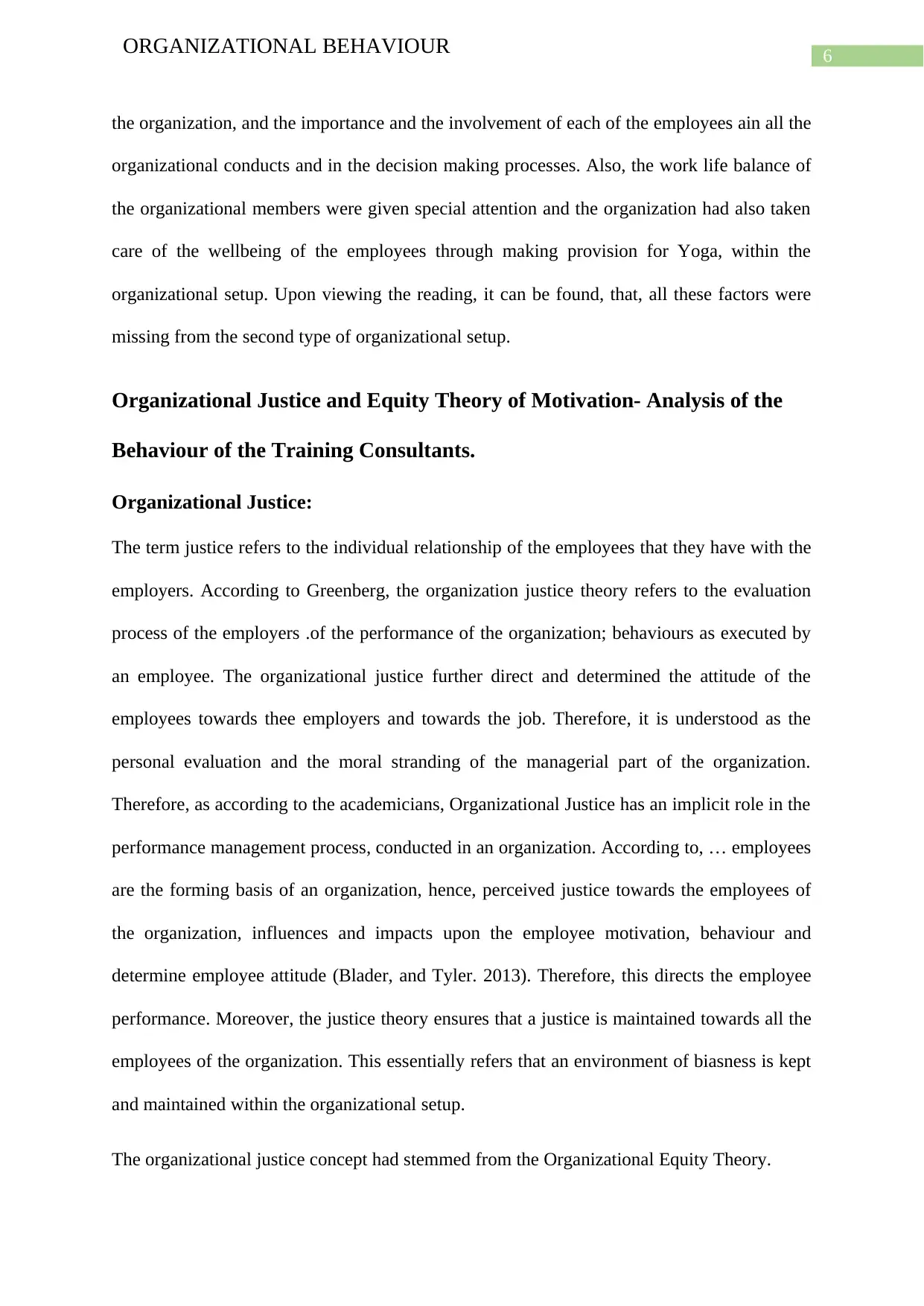
6
ORGANIZATIONAL BEHAVIOUR
the organization, and the importance and the involvement of each of the employees ain all the
organizational conducts and in the decision making processes. Also, the work life balance of
the organizational members were given special attention and the organization had also taken
care of the wellbeing of the employees through making provision for Yoga, within the
organizational setup. Upon viewing the reading, it can be found, that, all these factors were
missing from the second type of organizational setup.
Organizational Justice and Equity Theory of Motivation- Analysis of the
Behaviour of the Training Consultants.
Organizational Justice:
The term justice refers to the individual relationship of the employees that they have with the
employers. According to Greenberg, the organization justice theory refers to the evaluation
process of the employers .of the performance of the organization; behaviours as executed by
an employee. The organizational justice further direct and determined the attitude of the
employees towards thee employers and towards the job. Therefore, it is understood as the
personal evaluation and the moral stranding of the managerial part of the organization.
Therefore, as according to the academicians, Organizational Justice has an implicit role in the
performance management process, conducted in an organization. According to, … employees
are the forming basis of an organization, hence, perceived justice towards the employees of
the organization, influences and impacts upon the employee motivation, behaviour and
determine employee attitude (Blader, and Tyler. 2013). Therefore, this directs the employee
performance. Moreover, the justice theory ensures that a justice is maintained towards all the
employees of the organization. This essentially refers that an environment of biasness is kept
and maintained within the organizational setup.
The organizational justice concept had stemmed from the Organizational Equity Theory.
ORGANIZATIONAL BEHAVIOUR
the organization, and the importance and the involvement of each of the employees ain all the
organizational conducts and in the decision making processes. Also, the work life balance of
the organizational members were given special attention and the organization had also taken
care of the wellbeing of the employees through making provision for Yoga, within the
organizational setup. Upon viewing the reading, it can be found, that, all these factors were
missing from the second type of organizational setup.
Organizational Justice and Equity Theory of Motivation- Analysis of the
Behaviour of the Training Consultants.
Organizational Justice:
The term justice refers to the individual relationship of the employees that they have with the
employers. According to Greenberg, the organization justice theory refers to the evaluation
process of the employers .of the performance of the organization; behaviours as executed by
an employee. The organizational justice further direct and determined the attitude of the
employees towards thee employers and towards the job. Therefore, it is understood as the
personal evaluation and the moral stranding of the managerial part of the organization.
Therefore, as according to the academicians, Organizational Justice has an implicit role in the
performance management process, conducted in an organization. According to, … employees
are the forming basis of an organization, hence, perceived justice towards the employees of
the organization, influences and impacts upon the employee motivation, behaviour and
determine employee attitude (Blader, and Tyler. 2013). Therefore, this directs the employee
performance. Moreover, the justice theory ensures that a justice is maintained towards all the
employees of the organization. This essentially refers that an environment of biasness is kept
and maintained within the organizational setup.
The organizational justice concept had stemmed from the Organizational Equity Theory.
Paraphrase This Document
Need a fresh take? Get an instant paraphrase of this document with our AI Paraphraser
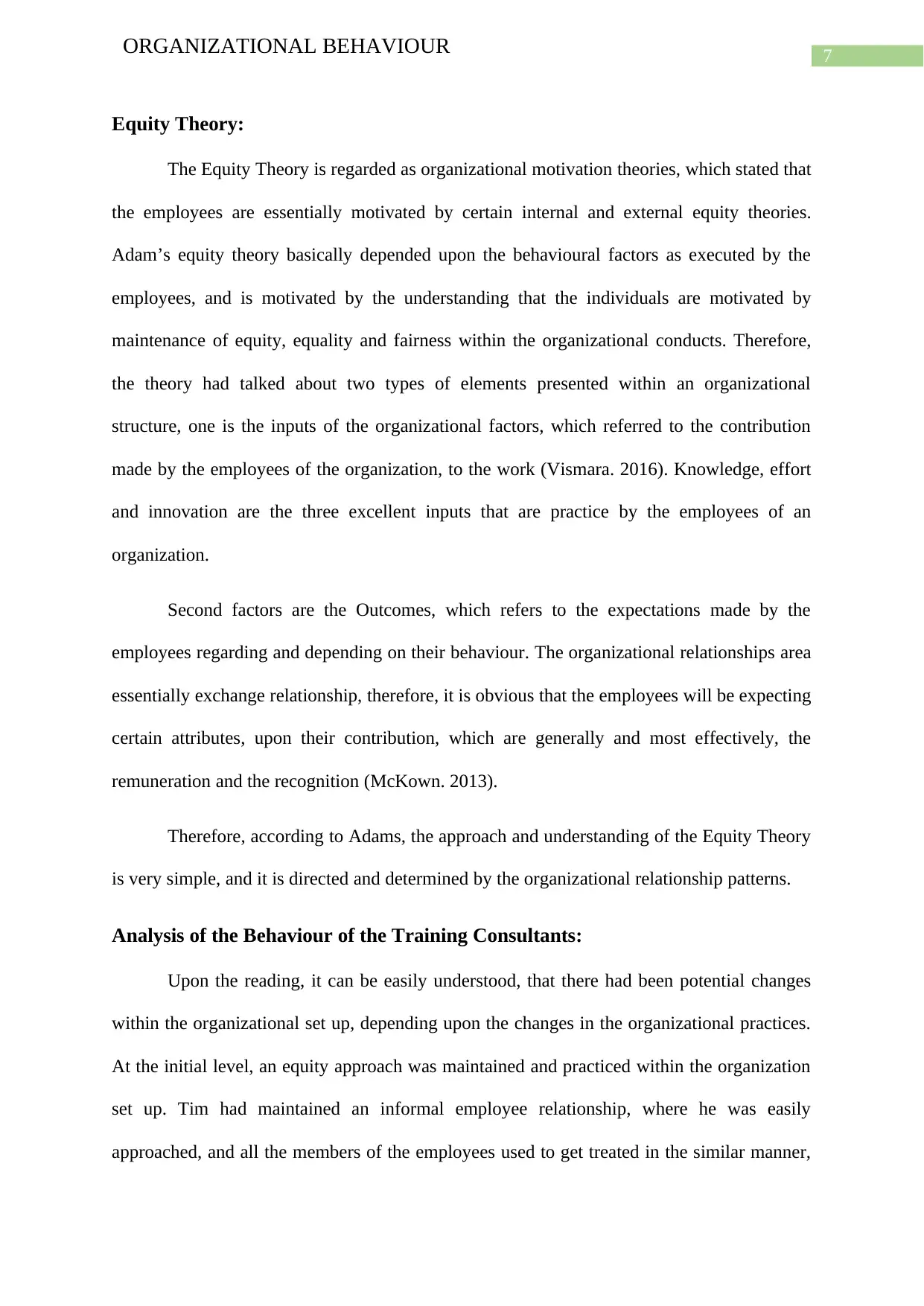
7
ORGANIZATIONAL BEHAVIOUR
Equity Theory:
The Equity Theory is regarded as organizational motivation theories, which stated that
the employees are essentially motivated by certain internal and external equity theories.
Adam’s equity theory basically depended upon the behavioural factors as executed by the
employees, and is motivated by the understanding that the individuals are motivated by
maintenance of equity, equality and fairness within the organizational conducts. Therefore,
the theory had talked about two types of elements presented within an organizational
structure, one is the inputs of the organizational factors, which referred to the contribution
made by the employees of the organization, to the work (Vismara. 2016). Knowledge, effort
and innovation are the three excellent inputs that are practice by the employees of an
organization.
Second factors are the Outcomes, which refers to the expectations made by the
employees regarding and depending on their behaviour. The organizational relationships area
essentially exchange relationship, therefore, it is obvious that the employees will be expecting
certain attributes, upon their contribution, which are generally and most effectively, the
remuneration and the recognition (McKown. 2013).
Therefore, according to Adams, the approach and understanding of the Equity Theory
is very simple, and it is directed and determined by the organizational relationship patterns.
Analysis of the Behaviour of the Training Consultants:
Upon the reading, it can be easily understood, that there had been potential changes
within the organizational set up, depending upon the changes in the organizational practices.
At the initial level, an equity approach was maintained and practiced within the organization
set up. Tim had maintained an informal employee relationship, where he was easily
approached, and all the members of the employees used to get treated in the similar manner,
ORGANIZATIONAL BEHAVIOUR
Equity Theory:
The Equity Theory is regarded as organizational motivation theories, which stated that
the employees are essentially motivated by certain internal and external equity theories.
Adam’s equity theory basically depended upon the behavioural factors as executed by the
employees, and is motivated by the understanding that the individuals are motivated by
maintenance of equity, equality and fairness within the organizational conducts. Therefore,
the theory had talked about two types of elements presented within an organizational
structure, one is the inputs of the organizational factors, which referred to the contribution
made by the employees of the organization, to the work (Vismara. 2016). Knowledge, effort
and innovation are the three excellent inputs that are practice by the employees of an
organization.
Second factors are the Outcomes, which refers to the expectations made by the
employees regarding and depending on their behaviour. The organizational relationships area
essentially exchange relationship, therefore, it is obvious that the employees will be expecting
certain attributes, upon their contribution, which are generally and most effectively, the
remuneration and the recognition (McKown. 2013).
Therefore, according to Adams, the approach and understanding of the Equity Theory
is very simple, and it is directed and determined by the organizational relationship patterns.
Analysis of the Behaviour of the Training Consultants:
Upon the reading, it can be easily understood, that there had been potential changes
within the organizational set up, depending upon the changes in the organizational practices.
At the initial level, an equity approach was maintained and practiced within the organization
set up. Tim had maintained an informal employee relationship, where he was easily
approached, and all the members of the employees used to get treated in the similar manner,
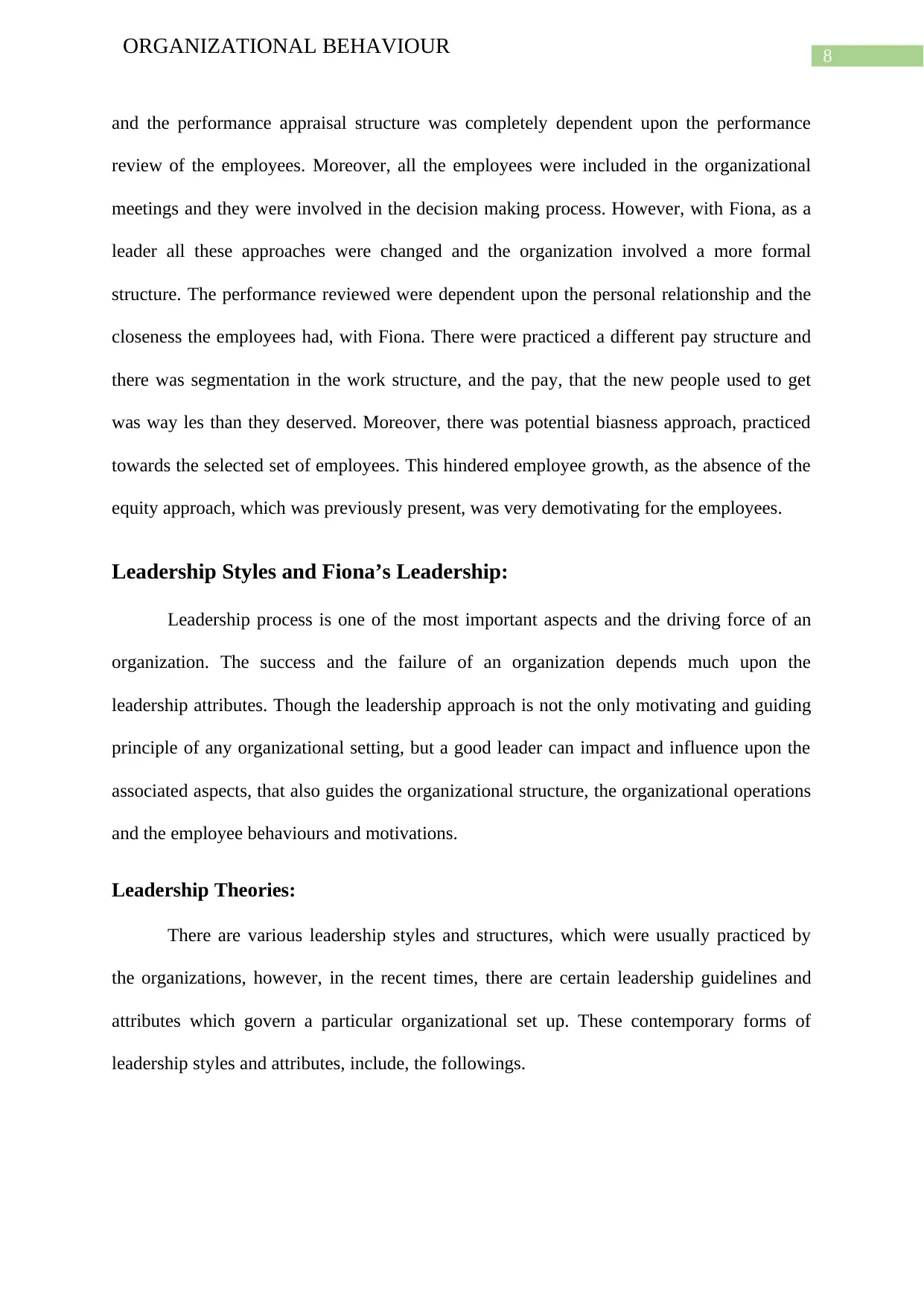
8
ORGANIZATIONAL BEHAVIOUR
and the performance appraisal structure was completely dependent upon the performance
review of the employees. Moreover, all the employees were included in the organizational
meetings and they were involved in the decision making process. However, with Fiona, as a
leader all these approaches were changed and the organization involved a more formal
structure. The performance reviewed were dependent upon the personal relationship and the
closeness the employees had, with Fiona. There were practiced a different pay structure and
there was segmentation in the work structure, and the pay, that the new people used to get
was way les than they deserved. Moreover, there was potential biasness approach, practiced
towards the selected set of employees. This hindered employee growth, as the absence of the
equity approach, which was previously present, was very demotivating for the employees.
Leadership Styles and Fiona’s Leadership:
Leadership process is one of the most important aspects and the driving force of an
organization. The success and the failure of an organization depends much upon the
leadership attributes. Though the leadership approach is not the only motivating and guiding
principle of any organizational setting, but a good leader can impact and influence upon the
associated aspects, that also guides the organizational structure, the organizational operations
and the employee behaviours and motivations.
Leadership Theories:
There are various leadership styles and structures, which were usually practiced by
the organizations, however, in the recent times, there are certain leadership guidelines and
attributes which govern a particular organizational set up. These contemporary forms of
leadership styles and attributes, include, the followings.
ORGANIZATIONAL BEHAVIOUR
and the performance appraisal structure was completely dependent upon the performance
review of the employees. Moreover, all the employees were included in the organizational
meetings and they were involved in the decision making process. However, with Fiona, as a
leader all these approaches were changed and the organization involved a more formal
structure. The performance reviewed were dependent upon the personal relationship and the
closeness the employees had, with Fiona. There were practiced a different pay structure and
there was segmentation in the work structure, and the pay, that the new people used to get
was way les than they deserved. Moreover, there was potential biasness approach, practiced
towards the selected set of employees. This hindered employee growth, as the absence of the
equity approach, which was previously present, was very demotivating for the employees.
Leadership Styles and Fiona’s Leadership:
Leadership process is one of the most important aspects and the driving force of an
organization. The success and the failure of an organization depends much upon the
leadership attributes. Though the leadership approach is not the only motivating and guiding
principle of any organizational setting, but a good leader can impact and influence upon the
associated aspects, that also guides the organizational structure, the organizational operations
and the employee behaviours and motivations.
Leadership Theories:
There are various leadership styles and structures, which were usually practiced by
the organizations, however, in the recent times, there are certain leadership guidelines and
attributes which govern a particular organizational set up. These contemporary forms of
leadership styles and attributes, include, the followings.
⊘ This is a preview!⊘
Do you want full access?
Subscribe today to unlock all pages.

Trusted by 1+ million students worldwide
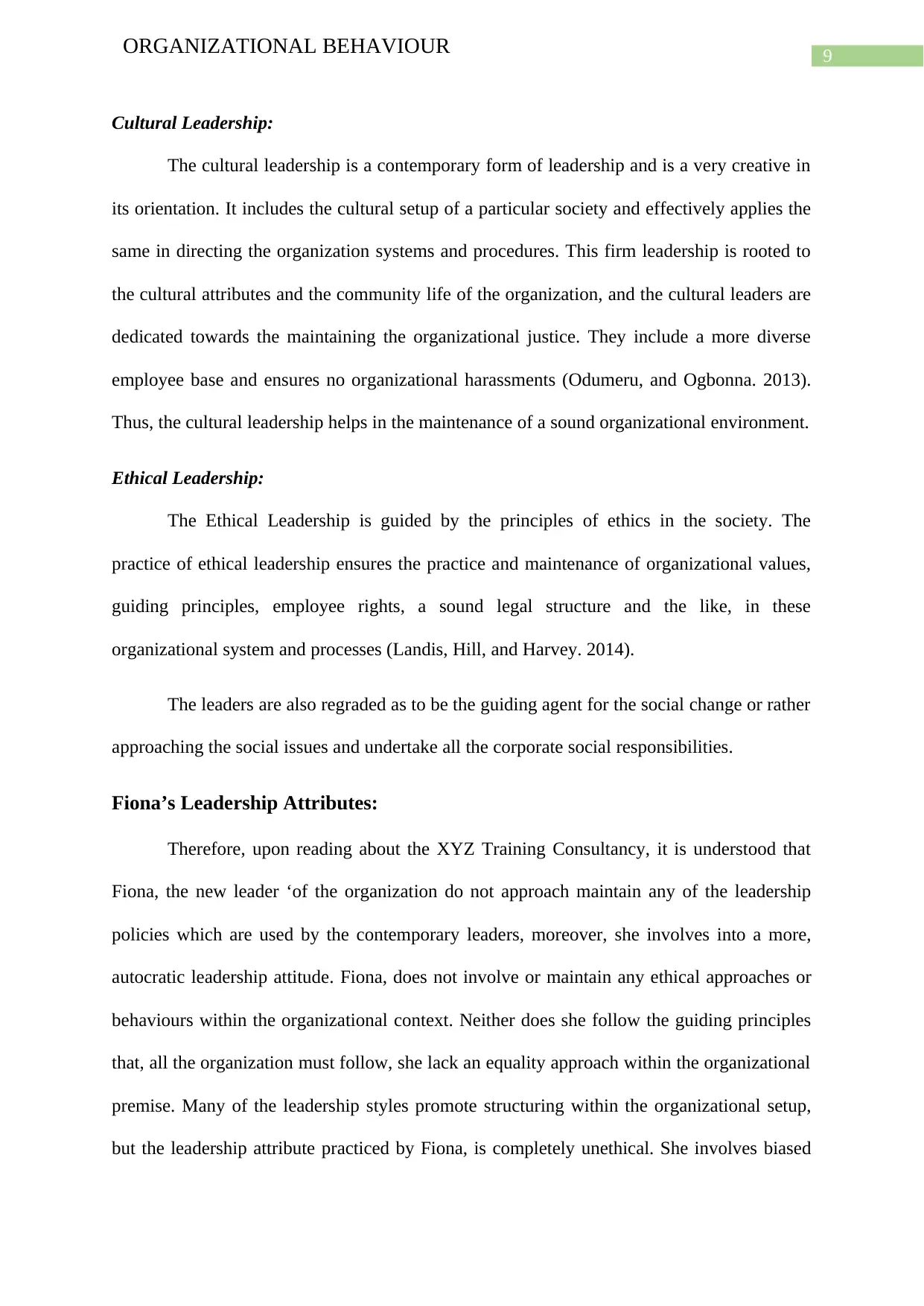
9
ORGANIZATIONAL BEHAVIOUR
Cultural Leadership:
The cultural leadership is a contemporary form of leadership and is a very creative in
its orientation. It includes the cultural setup of a particular society and effectively applies the
same in directing the organization systems and procedures. This firm leadership is rooted to
the cultural attributes and the community life of the organization, and the cultural leaders are
dedicated towards the maintaining the organizational justice. They include a more diverse
employee base and ensures no organizational harassments (Odumeru, and Ogbonna. 2013).
Thus, the cultural leadership helps in the maintenance of a sound organizational environment.
Ethical Leadership:
The Ethical Leadership is guided by the principles of ethics in the society. The
practice of ethical leadership ensures the practice and maintenance of organizational values,
guiding principles, employee rights, a sound legal structure and the like, in these
organizational system and processes (Landis, Hill, and Harvey. 2014).
The leaders are also regraded as to be the guiding agent for the social change or rather
approaching the social issues and undertake all the corporate social responsibilities.
Fiona’s Leadership Attributes:
Therefore, upon reading about the XYZ Training Consultancy, it is understood that
Fiona, the new leader ‘of the organization do not approach maintain any of the leadership
policies which are used by the contemporary leaders, moreover, she involves into a more,
autocratic leadership attitude. Fiona, does not involve or maintain any ethical approaches or
behaviours within the organizational context. Neither does she follow the guiding principles
that, all the organization must follow, she lack an equality approach within the organizational
premise. Many of the leadership styles promote structuring within the organizational setup,
but the leadership attribute practiced by Fiona, is completely unethical. She involves biased
ORGANIZATIONAL BEHAVIOUR
Cultural Leadership:
The cultural leadership is a contemporary form of leadership and is a very creative in
its orientation. It includes the cultural setup of a particular society and effectively applies the
same in directing the organization systems and procedures. This firm leadership is rooted to
the cultural attributes and the community life of the organization, and the cultural leaders are
dedicated towards the maintaining the organizational justice. They include a more diverse
employee base and ensures no organizational harassments (Odumeru, and Ogbonna. 2013).
Thus, the cultural leadership helps in the maintenance of a sound organizational environment.
Ethical Leadership:
The Ethical Leadership is guided by the principles of ethics in the society. The
practice of ethical leadership ensures the practice and maintenance of organizational values,
guiding principles, employee rights, a sound legal structure and the like, in these
organizational system and processes (Landis, Hill, and Harvey. 2014).
The leaders are also regraded as to be the guiding agent for the social change or rather
approaching the social issues and undertake all the corporate social responsibilities.
Fiona’s Leadership Attributes:
Therefore, upon reading about the XYZ Training Consultancy, it is understood that
Fiona, the new leader ‘of the organization do not approach maintain any of the leadership
policies which are used by the contemporary leaders, moreover, she involves into a more,
autocratic leadership attitude. Fiona, does not involve or maintain any ethical approaches or
behaviours within the organizational context. Neither does she follow the guiding principles
that, all the organization must follow, she lack an equality approach within the organizational
premise. Many of the leadership styles promote structuring within the organizational setup,
but the leadership attribute practiced by Fiona, is completely unethical. She involves biased
Paraphrase This Document
Need a fresh take? Get an instant paraphrase of this document with our AI Paraphraser
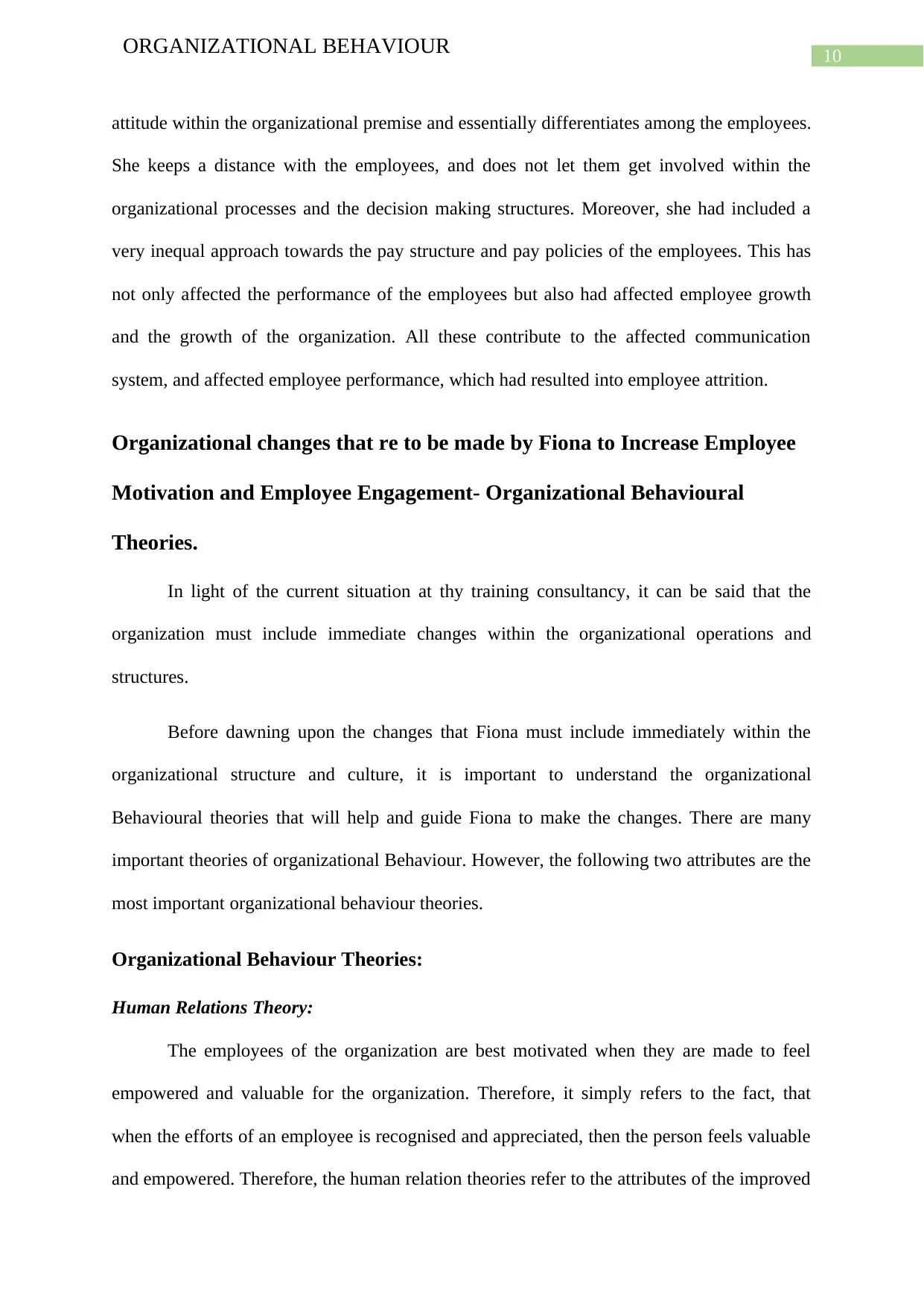
10
ORGANIZATIONAL BEHAVIOUR
attitude within the organizational premise and essentially differentiates among the employees.
She keeps a distance with the employees, and does not let them get involved within the
organizational processes and the decision making structures. Moreover, she had included a
very inequal approach towards the pay structure and pay policies of the employees. This has
not only affected the performance of the employees but also had affected employee growth
and the growth of the organization. All these contribute to the affected communication
system, and affected employee performance, which had resulted into employee attrition.
Organizational changes that re to be made by Fiona to Increase Employee
Motivation and Employee Engagement- Organizational Behavioural
Theories.
In light of the current situation at thy training consultancy, it can be said that the
organization must include immediate changes within the organizational operations and
structures.
Before dawning upon the changes that Fiona must include immediately within the
organizational structure and culture, it is important to understand the organizational
Behavioural theories that will help and guide Fiona to make the changes. There are many
important theories of organizational Behaviour. However, the following two attributes are the
most important organizational behaviour theories.
Organizational Behaviour Theories:
Human Relations Theory:
The employees of the organization are best motivated when they are made to feel
empowered and valuable for the organization. Therefore, it simply refers to the fact, that
when the efforts of an employee is recognised and appreciated, then the person feels valuable
and empowered. Therefore, the human relation theories refer to the attributes of the improved
ORGANIZATIONAL BEHAVIOUR
attitude within the organizational premise and essentially differentiates among the employees.
She keeps a distance with the employees, and does not let them get involved within the
organizational processes and the decision making structures. Moreover, she had included a
very inequal approach towards the pay structure and pay policies of the employees. This has
not only affected the performance of the employees but also had affected employee growth
and the growth of the organization. All these contribute to the affected communication
system, and affected employee performance, which had resulted into employee attrition.
Organizational changes that re to be made by Fiona to Increase Employee
Motivation and Employee Engagement- Organizational Behavioural
Theories.
In light of the current situation at thy training consultancy, it can be said that the
organization must include immediate changes within the organizational operations and
structures.
Before dawning upon the changes that Fiona must include immediately within the
organizational structure and culture, it is important to understand the organizational
Behavioural theories that will help and guide Fiona to make the changes. There are many
important theories of organizational Behaviour. However, the following two attributes are the
most important organizational behaviour theories.
Organizational Behaviour Theories:
Human Relations Theory:
The employees of the organization are best motivated when they are made to feel
empowered and valuable for the organization. Therefore, it simply refers to the fact, that
when the efforts of an employee is recognised and appreciated, then the person feels valuable
and empowered. Therefore, the human relation theories refer to the attributes of the improved
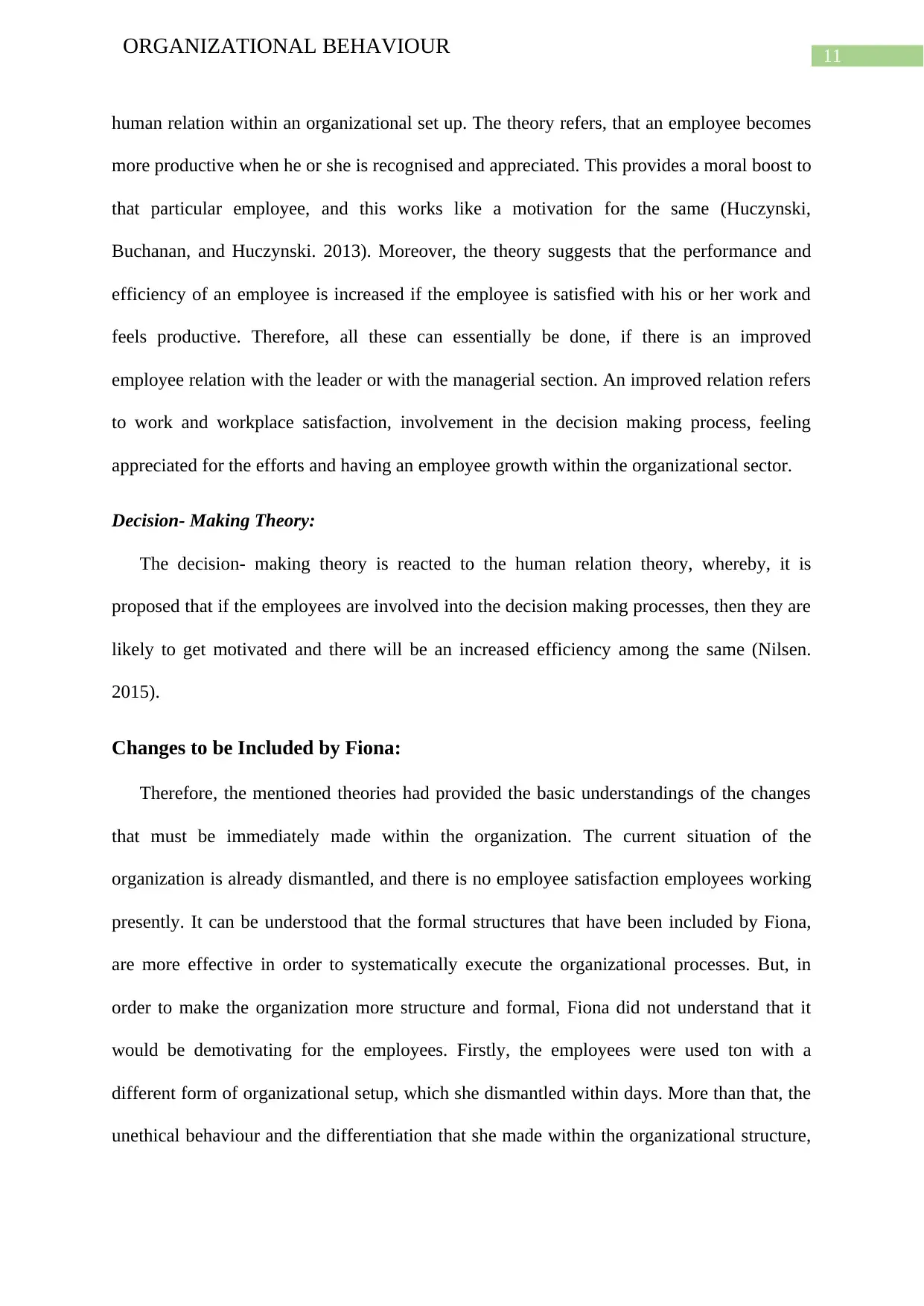
11
ORGANIZATIONAL BEHAVIOUR
human relation within an organizational set up. The theory refers, that an employee becomes
more productive when he or she is recognised and appreciated. This provides a moral boost to
that particular employee, and this works like a motivation for the same (Huczynski,
Buchanan, and Huczynski. 2013). Moreover, the theory suggests that the performance and
efficiency of an employee is increased if the employee is satisfied with his or her work and
feels productive. Therefore, all these can essentially be done, if there is an improved
employee relation with the leader or with the managerial section. An improved relation refers
to work and workplace satisfaction, involvement in the decision making process, feeling
appreciated for the efforts and having an employee growth within the organizational sector.
Decision- Making Theory:
The decision- making theory is reacted to the human relation theory, whereby, it is
proposed that if the employees are involved into the decision making processes, then they are
likely to get motivated and there will be an increased efficiency among the same (Nilsen.
2015).
Changes to be Included by Fiona:
Therefore, the mentioned theories had provided the basic understandings of the changes
that must be immediately made within the organization. The current situation of the
organization is already dismantled, and there is no employee satisfaction employees working
presently. It can be understood that the formal structures that have been included by Fiona,
are more effective in order to systematically execute the organizational processes. But, in
order to make the organization more structure and formal, Fiona did not understand that it
would be demotivating for the employees. Firstly, the employees were used ton with a
different form of organizational setup, which she dismantled within days. More than that, the
unethical behaviour and the differentiation that she made within the organizational structure,
ORGANIZATIONAL BEHAVIOUR
human relation within an organizational set up. The theory refers, that an employee becomes
more productive when he or she is recognised and appreciated. This provides a moral boost to
that particular employee, and this works like a motivation for the same (Huczynski,
Buchanan, and Huczynski. 2013). Moreover, the theory suggests that the performance and
efficiency of an employee is increased if the employee is satisfied with his or her work and
feels productive. Therefore, all these can essentially be done, if there is an improved
employee relation with the leader or with the managerial section. An improved relation refers
to work and workplace satisfaction, involvement in the decision making process, feeling
appreciated for the efforts and having an employee growth within the organizational sector.
Decision- Making Theory:
The decision- making theory is reacted to the human relation theory, whereby, it is
proposed that if the employees are involved into the decision making processes, then they are
likely to get motivated and there will be an increased efficiency among the same (Nilsen.
2015).
Changes to be Included by Fiona:
Therefore, the mentioned theories had provided the basic understandings of the changes
that must be immediately made within the organization. The current situation of the
organization is already dismantled, and there is no employee satisfaction employees working
presently. It can be understood that the formal structures that have been included by Fiona,
are more effective in order to systematically execute the organizational processes. But, in
order to make the organization more structure and formal, Fiona did not understand that it
would be demotivating for the employees. Firstly, the employees were used ton with a
different form of organizational setup, which she dismantled within days. More than that, the
unethical behaviour and the differentiation that she made within the organizational structure,
⊘ This is a preview!⊘
Do you want full access?
Subscribe today to unlock all pages.

Trusted by 1+ million students worldwide
1 out of 15
Related Documents
Your All-in-One AI-Powered Toolkit for Academic Success.
+13062052269
info@desklib.com
Available 24*7 on WhatsApp / Email
![[object Object]](/_next/static/media/star-bottom.7253800d.svg)
Unlock your academic potential
Copyright © 2020–2025 A2Z Services. All Rights Reserved. Developed and managed by ZUCOL.





